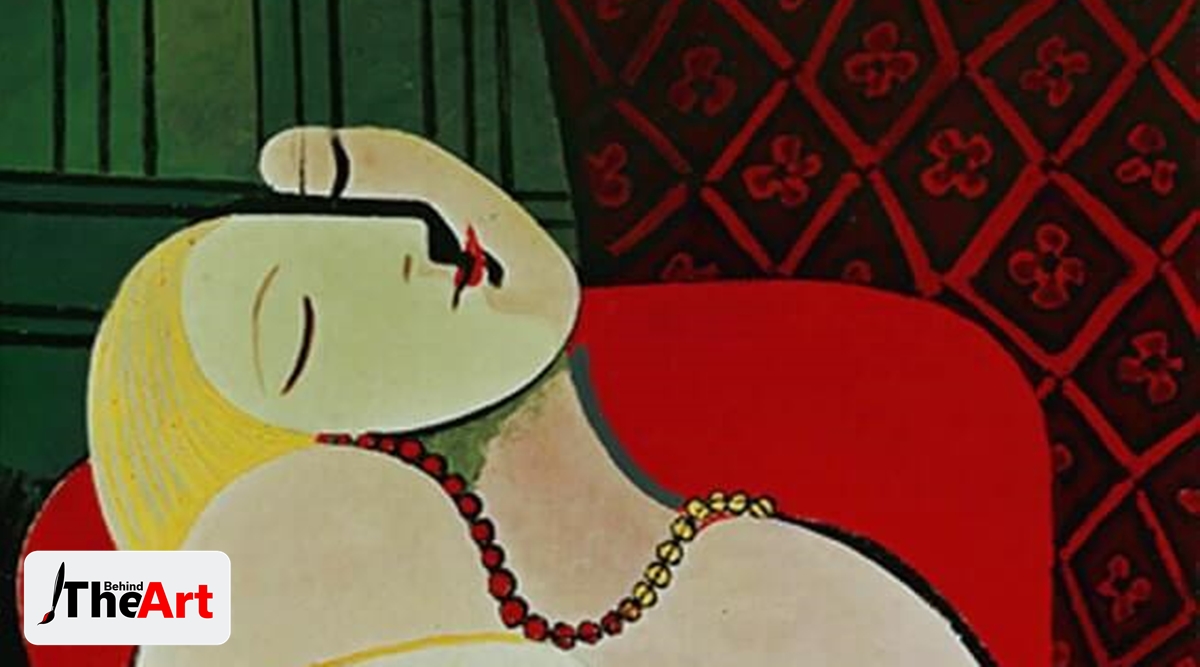
Le Rêve, also known as The Dream, is one of the most expensive paintings ever sold by Pablo Picasso. The painting was sold privately for $155 million on March 26, 2013, and is known for its contrasted colours and oversimplified outlines as it belongs to Picasso’s period of distorted depictions. Made in 1932 using oil on canvas, Picasso then 50 years old, portrayed his 22-year-old mistress Marie-Thérèse Walter. Critics have pointed out that Picasso painted an erect penis, presumably to represent his own, in the upturned face of his model, highlighting the painting’s erotic content. But what is the story behind this painting and why is it so significant?
Story Behind the Art
Everyone by now is aware of the troubled relationship between Pablo Picasso and his muse Marie-Thérèse Walter but what came out of their affair were several masterpieces by the Spanish artist. Walter was almost 30 years Picasso’s junior when they first met in 1927. Before Walter became pregnant and the affair was discovered by Picasso’s wife, Olga, the artist and his muse engaged in a covert affair for more than eight years. Picasso was also having an affair with Dora Maar at the time. The artist suggested that the two of his muses compete for his love. Until the beginning of the 1940s, Walter continued to collaborate with Picasso. The painting of Marie-Thérèse that Picasso called “Le Rêve” is from the time when he painted distorted depictions of his subjects using contrasted colours and simple, clean outlines. In 1941, it was first sold for $7,000, and in 1997, at an auction hosted by Christie’s, it was purchased for $48.4 million.
What does the painting represent?
According to several critics, the upturned face of this portrait suggests that the artist is creating an abstract version of his penis. This kind of abstract eroticism can be seen in Georgia O’Keeffe’s and many other well-known 20th-century paintings. The Dream was finished just two weeks before Marie-Thérèse showed up in Reading. She is shown in asleep in an armchair. The colour scheme used here, which Picasso used in a lot of his work around this time, gives the impression of sensuality. The composition was completed with strong lines and soft pastel colours, which exuded a contemporary vibe. The sharp lines he uses to show her fingers and the fine detail in the background will make some people think of Henri Matisse’s Music and The Dance paintings. As the young lady sleeps, the revealing pose suggests sexuality and vulnerability. Here, Picasso faithfully depicts her renowned long blonde hair by using yellow to contrast aggressively with the darker background. Her beaded necklace, which is delicately balanced on her meditative chest, then repeats the hues of red and yellow. Perhaps this scene reveals the young woman’s hair, curved figure, and undeniable beauty, which attracted her elderly lover the most. The domestic setting of this scene should suggest comfort and privacy, a private moment between these two passionate lovers. Although many people consider this to be a cubist piece, it can be argued that it was part of his surrealist period, and the colour scheme suggests fauvism. Picasso was breaking new ground in art history at this time, necessitating new classifications because of his distinctive ideas and styles that produced art in previously unheard-of ways.
Controversy and Wynn incident
No famous painting is complete without a little bit of controversy. Controversies help garner talk about the artist and his work and help the artworks stay alive centuries later. The fact that Picasso has depicted an erect penis over the face of a woman has caused a little controversy over time. It is common for artists to include hidden messages, concepts, or designs in their paintings, and the painting’s apparent similarity encourages critics to believe that Picasso drew his penis. This could represent sex itself or the model’s possession or influence by the artist.
And then there is the Wynn incident. A six-inch tear in the middle of the left side of the painting was caused by one of the previous owners striking his elbow on the canvas. Due to the owner’s name, the incident was dubbed the Wynn incident, and it also significantly decreased the value of the painting itself. Wynn had announced to a group of his friends in October 2006 that he had agreed to sell Le Rêve to Steve Cohen for $139 million and then according to sources, Wynn put his right elbow through the canvas while he was showing the painting to his friends, presumably about to reveal the now officially undisclosed previous owner. After a $90,000 repair, the painting was re-valued at $85 million, as Wynn later stated that he took the event as a warning not to sell it.
However, the painting’s legacy and controversy are so great that even though the tear was patched up later, people still considered it valuable and the painting was purchased by SAC Capital’s Steven A. Cohen for $155 million, according to the New York Post on March 26, 2013.
Advertisement
Next up in Behind the Art: What is the story behind Claude Monet’s “Water Lilies”? Why are they so famous?
📣 For more lifestyle news, follow us on Instagram | Twitter | Facebook and don’t miss out on the latest updates!
"behind" - Google News
February 26, 2023 at 02:00PM
https://ift.tt/8Z41evn
Behind the Art: What is the story behind Pablo Picasso’s Le Rêve which is worth $155 million? - The Indian Express
"behind" - Google News
https://ift.tt/3U86H0L
https://ift.tt/IrTNq9c
Bagikan Berita Ini














0 Response to "Behind the Art: What is the story behind Pablo Picasso’s Le Rêve which is worth $155 million? - The Indian Express"
Post a Comment